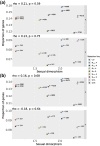Sex-Biased Gene Expression Under Sexually Antagonistic and Sex-Limited Selection
- PMID: 40729508
- PMCID: PMC12371189
- DOI: 10.1093/molbev/msaf178
Sex-Biased Gene Expression Under Sexually Antagonistic and Sex-Limited Selection
Abstract
Sex differences in gene expression are ubiquitous, evolve quickly, and are expected to underlie phenotypic sexual dimorphism (SD). Despite long-standing interest, the impact of sex-specific selection on the transcriptome remains poorly understood. Here, we test fundamental questions on the role of constraints on gene expression evolution arising from the mode of selection and genetic architecture. We also test the relationship between sex-biased expression and evolved SD. We assess these using body size selection lines in the seed beetle, Callosobruchus maculatus, that have evolved variation in SD in response to either sex-limited (SL) or sexually antagonistic (SA). We find that sex differences in the phenotypic responses and expression changes are generally well aligned. SL selection, despite a phenotypic response similar to SA selection in males, but not in females, resulted in a more extensive expression differentiation and increase of sex-biased expression than SA selection. These patterns show that SA selection imposes a transcriptomic constraint and is not required for sex-bias to evolve. Sex-biased transcripts show lower cross-sex correlations in expression changes than unbiased transcripts, suggesting greater sex differences in their underlying genetic architecture. Although male-biased transcripts are disproportionately affected when selection targeted males, we find no support for a transcriptome-wide association between sex-bias and SD. In the light of these unique experimental insights into how sex-specific selection on size changes adult transcription, our findings have important implications for inferring selection history and mode from patterns of sex-biased gene expression in natural populations.
Keywords: RNA-Seq; experimental evolution; intra-locus sexual conflict; sex-biased expression; sexual selection.
© The Author(s) 2025. Published by Oxford University Press on behalf of Society for Molecular Biology and Evolution.
Figures



Similar articles
-
Sexual Selection on Non-Ornamental Traits Is Underpinned by Evidence of Genetic Constraints on Sex-Biased Expression in Dusky Pipefish.Mol Ecol. 2025 Aug;34(15):e17550. doi: 10.1111/mec.17550. Epub 2024 Oct 14. Mol Ecol. 2025. PMID: 39400380 Free PMC article.
-
A cross-species analysis of neuroanatomical covariance sex differences in humans and mice.Biol Sex Differ. 2025 Jul 1;16(1):47. doi: 10.1186/s13293-025-00728-1. Biol Sex Differ. 2025. PMID: 40598550 Free PMC article.
-
Prescription of Controlled Substances: Benefits and Risks.2025 Jul 6. In: StatPearls [Internet]. Treasure Island (FL): StatPearls Publishing; 2025 Jan–. 2025 Jul 6. In: StatPearls [Internet]. Treasure Island (FL): StatPearls Publishing; 2025 Jan–. PMID: 30726003 Free Books & Documents.
-
Sexual conflict drive in the rapid evolution of new gametogenesis genes.Semin Cell Dev Biol. 2024 Jun-Jul;159-160:27-37. doi: 10.1016/j.semcdb.2024.01.005. Epub 2024 Feb 2. Semin Cell Dev Biol. 2024. PMID: 38309142 Review.
-
Systemic pharmacological treatments for chronic plaque psoriasis: a network meta-analysis.Cochrane Database Syst Rev. 2021 Apr 19;4(4):CD011535. doi: 10.1002/14651858.CD011535.pub4. Cochrane Database Syst Rev. 2021. Update in: Cochrane Database Syst Rev. 2022 May 23;5:CD011535. doi: 10.1002/14651858.CD011535.pub5. PMID: 33871055 Free PMC article. Updated.
References
MeSH terms
Grants and funding
- SNP&SEQ Technology Platform
- National Genomics Infrastructure
- Sweden and Science for Life Laboratory
- SNIC 2022/5-83/Swedish National Infrastructure for Computing at UPPMAX
- 2022/6-37/Swedish National Infrastructure for Computing at UPPMAX
- 2023/5-111/Swedish National Infrastructure for Computing at UPPMAX
- 2023/6-65/Swedish National Infrastructure for Computing at UPPMAX
- 2019-05038/Swedish Research Council
- 2023-04869/Swedish Research Council
- 2022-03701/Swedish Research Council
- CTS-18:163/Carl Tryggers foundation
- CTS-19:155/Carl Tryggers foundation
- 101061664/Marie Skłodowska-Curie Actions
- The Nilsson-Ehe Endowment
- 40933/Stiftelsen Lars Hiertas Minne
- FO2019-0329/Stiftelsen Lars Hiertas Minne
- S2024-0007/Birgitta Sintring Foundation
LinkOut - more resources
Full Text Sources

